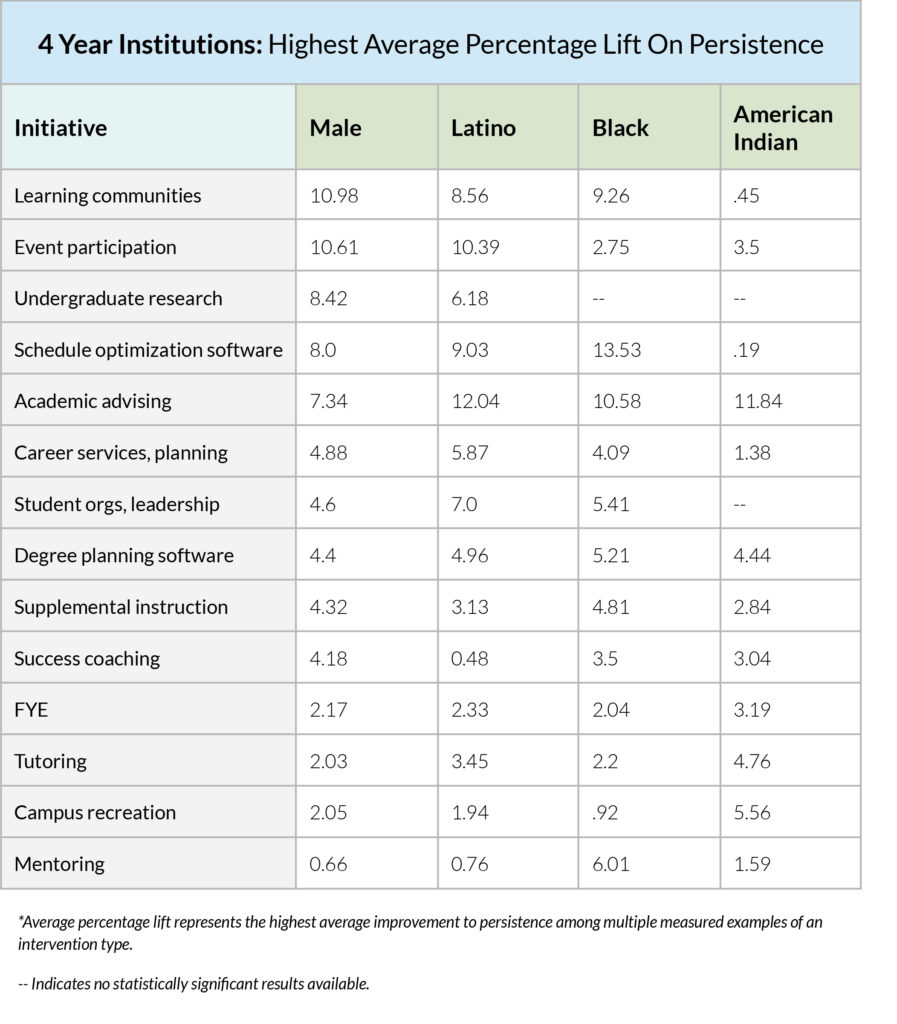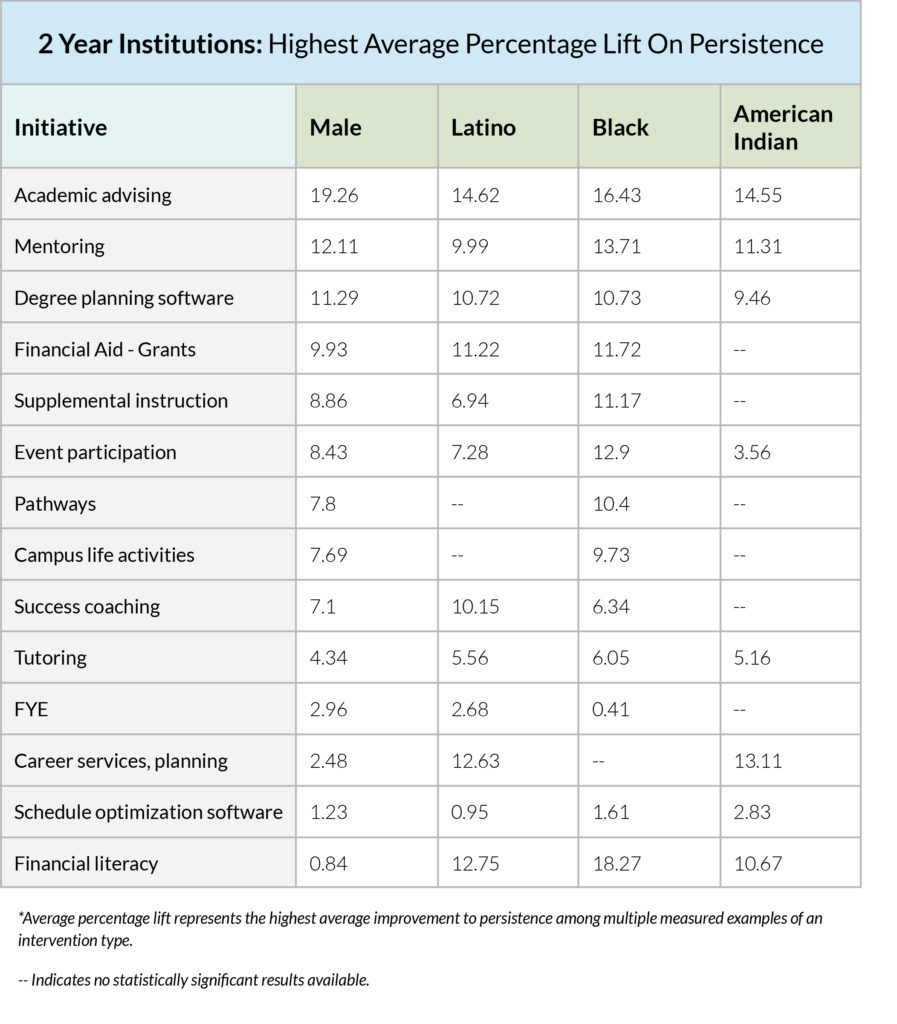
Improving Male Retention with Student Success Analytics
Share this Post
We need to talk about male college enrollment across the country.
An unlikely group to perceive as disadvantaged or needing special attention, it’s clear that men today are disengaging from higher education at record rates. While many schools have experienced this firsthand, data from the National Student Clearinghouse in the fall of 2020 and the spring of 2021 alerted us all that men’s enrollments are at the lowest rates ever, particularly at community colleges.
The declines are most extreme among black men and Latinos, representing setbacks for groups already at the center of attention in higher ed’s pursuit of equitable outcomes. These declines didn’t materialize out of thin air — female college enrollment and completion have exceeded that of males for some time now. But if we don’t reverse this trend and re-engage men in higher education, the ramifications for society will be significant.
There are plenty of articles in the press about the disappearance of men from college. Some speculate about causes specific to the pandemic, such as economic uncertainty. Others point to broader, more persistent factors, such as the pressure for men to be earners and the negative implications of performative masculinity. The causes, certainly nuanced and layered, merit attention to developing caring, well-informed responses and effective solutions.
In the meantime, it is quite evident that higher education is not sufficiently meeting the needs of men today, particularly men of color. Most of us who have worked in student services at a college or university know firsthand how challenging it can be to engage male students and get them to take advantage of all we offer.
Start With What Works for Male Students On Your Campus
So how can we better support men in higher education to make them feel welcome, engaged, and successful?
Most colleges and universities are just starting to grapple with this issue. Still, male student success initiatives have been in play at some institutions, particularly those serving large minority populations. Scholarly research also provides insight into what works for men. Still, typically those studies are one-off, limited in scope, and conducted at institutions that may or may not be similar to yours. Even with practices demonstrated as effective by peers and in the literature, differences in implementation and varied populations make replicable results highly uncertain.
Let’s face it. It isn’t easy to glean the information necessary to launch a comprehensive initiative that will likely support male students’ needs today. Most schools don’t have spare resources to spin up programming that may not work, and insincere or knee-jerk responses can do far more harm than good.
How the University of Texas at San Antonio Proactively Engages Male Students of Color
Rather than jumping headfirst into creating a new suite of male-centric services based on what others have done, a prudent first step in better-serving men at your institution is to look inward and understand what’s already happening. How well are men on your campus supported by current structures, services, programming, and interventions? The answer to this question can be found via two processes:
1) Discovery
Look at your institutional data to identify areas of concern where disparities in male engagement and performance are clear, and then investigate those areas with further data collection.
2) Evaluation
Measure the impact of your current services, programs, and interventions to understand how well they serve the men on your campus.
Analytics is instrumental in both of these processes. Descriptive, diagnostic, and predictive analytics help you discover areas of concern and signal-related factors to focus further investigation and action. Civitas Learning Initiative Analysis helps in understanding the effectiveness of ongoing efforts. It is this — impact analytics — where we can almost immediately make a difference at a very low cost. By examining the effectiveness of existing programs and support services using Initiative Analysis, it is possible to identify programs that will benefit men. From there, it costs relatively little to recruit male students to participate proactively.
Student Success Initiatives With the Highest Impact Male Students
A meta-analysis of 3094 student success initiative analyses, run by Civitas Learning partner institutions, looks at the extent to which a wide array of student success programs and interventions effectively supported male student persistence. These analyses were conducted from 2017 to 2020 by 84 diverse US campuses, including an even split of 2- and 4-year institutions. Civitas Learning Initiative Analysis employs a rigorous, prediction-based program efficacy analysis using propensity-score matching to determine statistically significant effects of interventions on term-to-term persistence.
The tables below show that each intervention type varies in its effectiveness at increasing persistence in 2- vs. 4-year institutions and by population. No one intervention is equally effective for all men. What works for male students at a community college differs from what is most effective at a 4-year university. Overall, what works for males may not be the most effective for specific male populations such as Latinos, black men, and American Indian men.
Each table below shows the highest average lift on persistence measured across multiple examples of interventions in that category.
For 4-year institutions, learning communities and event participation yielded double-digit gains in persistence for participating males compared to equally matched non-participating males. While having a positive impact on the persistence of men in general, the impact of academic advising on men of color was especially strong.

For 2-year institutions, academic advising, mentoring, degree planning software, and financial aid grants yielded double-digit gains in persistence for all men and men of color. Other interventions, such as success coaching and career services, had an uneven impact across different groups of men.

It is important to note that these data do not represent all 2- and 4-year institutions. Rather, they reflect an aggregation of what a subset of institutions has learned over four years via systematic, diligent analyses of their interventions. We can tell from these data that there is no one-size-fits-all intervention to keep male students enrolled. Each institution’s data will show different results for specific interventions and populations – that is exactly the point.
Equipped with this data, each school can now make informed decisions about the interventions they market to male students, especially if usage statistics are low among men for these services. They can also make improvements and adjustments to lower-performing interventions to generate better outcomes for men moving forward.
5 Steps Your Institution Can Take to Better Support Male Students
So, ready to get started? Here are some steps your institution can take today to understand how your team can best support your male students to stay enrolled.
Step One: Inventory Key Services and Interventions
Start by completing an inventory of key services and interventions (e.g., tutoring, supplemental instruction, advising, academic coaching, peer mentoring) at your institution. Collect usage data for each of the services and interventions on the list. Identify those used heavily by men and those underutilized in comparison to women. Are there apparent trends that signal gender differences in service preferences?
Student Success Initiative Inventory
Step Two: Prioritize Initiatives to Analyze
Prioritize the services and interventions that you want to investigate first. You can do this by volume of students served, perceived impact, or strongly anticipated evidence of gender differences in usage — whatever makes the most sense for your specific situation.
Step Three: Measure Initiative Effectiveness
Measure the impact of each service and intervention, specifically looking for disaggregated impact by gender and race/ethnicity.
Step Four: Determine What Works Well for Male Students and Why
Are there services and interventions that work particularly well for men and minority students? If so, examine the usage data for those services — do men underutilize them? Can you do more targeted marketing and direct referrals for those services heavily used by men? Who would be the best resources to encourage your male students to participate in these services, and via what communication channels?
Step Five: Investigate Opportunities to Improve Less Effective Services
Are there services that are not very effective for men and minorities? Consider speaking with the program director about these findings to develop a shared interpretation of why they may not generate equitable outcomes. Be careful to have a collaborative and constructive conversation, not judgemental. Student focus groups can help identify opportunities to make programmatic changes and improve the service’s impact on all populations. After making any changes, measure the impact again the following term to see if they were effective.
Design Impactful Male Student Success Initiatives
While nothing covered here addresses the challenges associated with recruiting men into higher education in equal numbers to women in the first place, we do have the analytic tools to inform the work of keeping already enrolled men engaged and supporting them through to completion. Do you know what works for your male students? What should your college or university include in its male student success initiative? Learning communities? Mentoring? Tutoring? Events? Coaching?
Used properly, analytics can identify and diagnose differential impacts of student success services and educational experiences contributing to equity gaps. The right data equips your team to design male student success initiatives with precision and certainty. Without it, we are just making our best guess, applying more one-size-fits-all approaches that are not working for college-going men today. It’s time to get serious about meeting the needs of men in higher education. Our men deserve better, and higher education’s recovery depends upon it.





